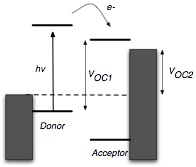Home / Research / Energy Conversion / Solar Cells / Metal Contacts
While the center of action in a nano-PV device is often taken to be the heterojunction wher e the excitons split to yield charges, most other parts of the device directly govern the transport and collection of the generated charges. This is particularly true for the electrodes used to collect the charges. A simple model predicts that the open-circuit voltage of these devices would depend directly on the difference in work-functions between the cathode and the anode. However, for many devices either this result does not hold or the dependence is unclear. The actual performance depends upon the nature of the contact formed between the metal electrode
e the excitons split to yield charges, most other parts of the device directly govern the transport and collection of the generated charges. This is particularly true for the electrodes used to collect the charges. A simple model predicts that the open-circuit voltage of these devices would depend directly on the difference in work-functions between the cathode and the anode. However, for many devices either this result does not hold or the dependence is unclear. The actual performance depends upon the nature of the contact formed between the metal electrode  and the photoactive material in question. This brings in a crucial dependece of the device performace on the geometry and electronic structure of, what is very often just the metal-semiconductor interface.
and the photoactive material in question. This brings in a crucial dependece of the device performace on the geometry and electronic structure of, what is very often just the metal-semiconductor interface.


Our focus in this work is to develop an understanding of precisely this aforementioned dependence and not only comment upon the properties expected of present-day PV structures but also suggest alternative device structures that may prove to yield higher efficiencies. The study is being carried out using high-level ab initio calculations to characterize the electronic structure, energy-level alignments and interface state properties of a variety of metal-semiconductor interfaces relevant to photovoltaics.
Metal Contacts

Massachusetts Institute of Technology, 77 Massachusetts Avenue, Cambridge MA 02139-4307

